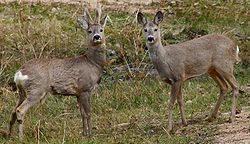| Capreolini | |
|---|---|
 | |
| Capreolus capreolus | |
| Scientific classification | |
| Kingdom: | Animalia |
| Phylum: | Chordata |
| Class: | Mammalia |
| Order: | Artiodactyla |
| Family: | Cervidae |
| Subfamily: | Capreolinae |
| Tribe: | Capreolini |
| Genera | |
Capreolini is a tribe of deer, containing two extant genera and one extinct genus. There are currently three extant species: the water deer, which is the only member of the genus Hydropotes, and European and Siberian roe deer, who comprise the genus Capreolus .